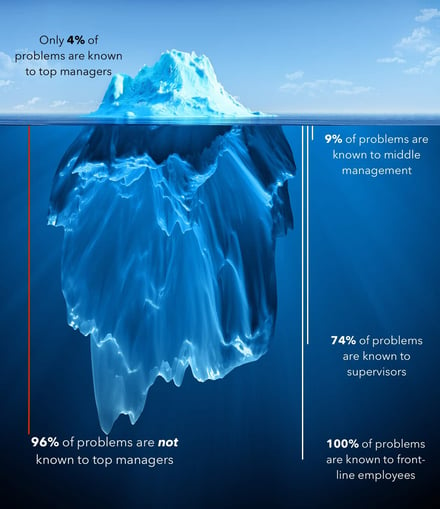Raise your hand if your organization is NOT working on patient flow.
Challenges with patient flow plague every hospital and health system in the country. They are some of the most complex and difficult-to-solve problems that healthcare clinicians and administrators encounter. It often feels like a game of whack-a-mole...as soon as one problem is solved another one appears...or Groundhog Day...why are we working on that again, I thought we solved that problem 6 months ago!?! As we all know by now, there is no silver bullet or one magic solution, but there are some common pitfalls that are made by leaders when trying to tackle patient flow.
Over the next 3 blogs, we will provide guidance on how to avoid making some of these common mistakes and harness the problem-solving power of your team to identify, implement, and support solutions that will stick.
In this post, we are going to tackle the topic of including frontline caregivers in the problem-solving process.
Pitfall: Designing improvements to patient flow without involving the caregivers who do the work
It is well-known that the further we get from where the work happens, the less we know about the problems being experienced. Sidney Yoshida’s model from over 3 decades ago, the Iceberg of Ignorance, is an excellent illustration of where the knowledge of problems in the work lies.
 As leaders, we often think we know the problems, but we may be receiving information that is limited in its view, only reflecting the symptoms of deeper issues, or, in some cases, what may be erroneous information. This can lead us down paths that do not address the root cause, distracting us from the true problems to be solved. It often produces solutions that may be temporary and unsustainable, do not fix the actual problem, or are fraught with resistance from those that do the work. In our current climate of staffing shortages, workforce burnout, financial constraints, and the ever-increasing demand for improved customer experience, we cannot continue to waste time of our patients and staff with ineffective solutions.
As leaders, we often think we know the problems, but we may be receiving information that is limited in its view, only reflecting the symptoms of deeper issues, or, in some cases, what may be erroneous information. This can lead us down paths that do not address the root cause, distracting us from the true problems to be solved. It often produces solutions that may be temporary and unsustainable, do not fix the actual problem, or are fraught with resistance from those that do the work. In our current climate of staffing shortages, workforce burnout, financial constraints, and the ever-increasing demand for improved customer experience, we cannot continue to waste time of our patients and staff with ineffective solutions.
Do this instead: Engage the caregivers in every step of the improvement process
Respect for every individual is at the heart of lean thinking. How can we honor and show respect for our caregivers if we do not engage them in the problem-solving process? We need their deep understanding of the work to identify the problems, flow-stoppers, barriers to following standards, as well as their insights into the customer experience. The usual resistance comes in the form of not being able to pull them away from their daily work...so get creative. Take the discussion to them, solicit the best thinking of your nurses with well-crafted questions during daily huddles, through surveys or real-time feedback while observing in the gemba, or schedule staff to come in before or after a shift. Meet with providers during their routine business meetings or schedule workshop time during off hours. If you are serious about fixing the problem once and for all, the downside of not including direct caregiver input always outweighs the barriers.
Frontline caregivers are the key to unlocking sustainable solutions. Since they are the ones most affected, it is their adoption of new processes and changes in behavior that is needed. If we engage the frontline in the performance improvement process, leadership provides staff with the agency to design their work in a way that meets the target while also meeting their needs. This agency puts them in the driver's seat, increasing their ownership and buy-in for the improvement. They become the advocates, selling the ideas to their co-workers.
We cannot expect creativity and innovation to come without challenging the status quo. So, if you want to amplify your results, ensure there is diversity across the team. Include staff from different professions, departments, backgrounds, and years of experience. This allows for diverse thoughts and ideas to come forward, leading to creative solutions. We often talk about initiatives and tactics for improving psychological safety and enhancing our DEIA...turn that into action by engaging the staff, seeking out diversity in our improvement teams, and letting them know their voice is important.
I invite you to share...what creative strategies have worked for you to engage the front line?
And I challenge you to think about ways to tap into the vast knowledge of your workforce as you tackle the systemic challenges around patient flow. Make the investment...it will be worth your time, effort, and expense. We cannot do it without them!
Join Value Capture on August 29th for a webinar: “Strategies for Reducing Length of Stay in Hospital Settings: A Multidisciplinary Approach.” You will have the chance to learn from our lean experts and directly from healthcare leaders who are experiencing remarkable results from applying lean thinking and principles to their most challenging flow problems.
Check out the other common pitfalls for improving patient flow and how you can avoid them.

Written by Alison Hartman
Alison Hartman, MHA, has over 20 years of experience leading transformational change in hospitals and healthcare systems to improve quality, safety, operational, and financial performance. She is a certified Six Sigma Black Belt, trained in Lean problem solving, with experience leading performance improvement projects and incorporating Lean thinking into daily management processes, healthcare facility design, and electronic health record implementations. Alison is a skilled facilitator, trainer, and coach in process improvement and patient safety. Alison most recently was the Vice President of Quality and Safety at a community-based health system. In addition, she has held a variety of leadership roles overseeing quality, patient safety, infection prevention, process improvement, and project management teams. These roles have provided hands-on expertise in the nuances of healthcare quality reporting, accreditation and regulatory requirements, and the establishment of effective quality management systems. Alison has designed and implemented comprehensive safety programs, that incorporated tiered daily huddles, event investigations, reward and recognition programs, and human error prevention and safety science training. Alison led a system-wide Just Culture rollout and is certified as a Just Culture champion. She is passionate about patient and employee safety, advocating that an environment of psychological safety is essential to the formation of a learning and improvement culture.

Submit a comment